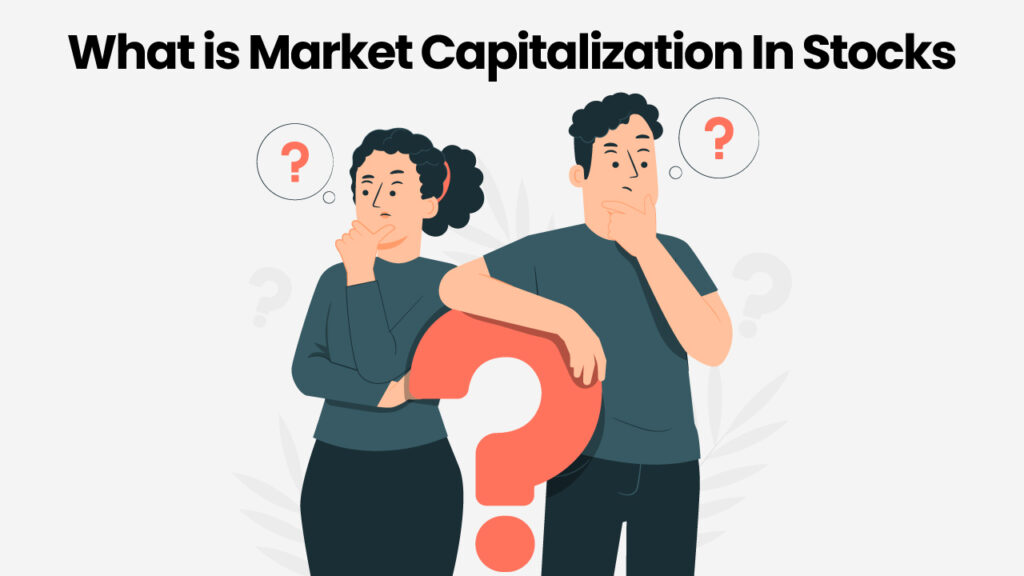Market capitalisation generally called the market cap of a company can be understood as the total market value of the company.
Market capitalization is used by investors all over the world to evaluate companies before buying their shares. There are three major types of market capitalization which are large cap, small cap, and mid cap.
How Market Capitalization is Calculated?
The formula for calculating the market capitalization of a company is given below
Market capitalization = Current Share Price * Total outstanding shares
For example, if a company has 10 crore outstanding shares, and each share is priced at ₹50, the market cap would be:
10,00,00,000 × 50 = ₹500 Crore (Market cap)
The figure obtained represents the market value of a company. It helps in comparing companies with their peers and identifying potential investment opportunities.
Categories of Market Capitalization
Companies in the stock market are often classified based on their market cap into three categories:
| Market Capitalization Category | Market Capitalization Range | Characteristics |
| Large Cap | Above ₹28,000 Cr | Very Stable, Bluechip Companies, Safe to invest |
| Mid Cap | Between 8,500 and 28,000 Cr | Emerging companies, riskier than large-cap, the potential for growth |
| Small Cap | Less than ₹8,500 Cr | Highly risky, high growth potential, small and relatively newer companies |
1. Large-Cap Stocks
Large-cap companies are often the market leaders in their sector or industry segment. Examples of large caps include blue-chip stocks like Reliance, HDFC Bank, and Infosys. Investors who are looking for stable returns and long-term growth often prefer to invest their money in large-cap stocks.
2. Mid-Cap Stocks
Mid-cap stocks are the companies that have a market cap somewhere between 8,500 and 28,000 Crore. These have generally shown significant growth but still have enough room for expansion. They come with slightly more risk factors. Example: Castrol and Jubilant Food.
3. Small-Cap Stocks
Small-cap stocks include companies having a market capitalization lesser than ₹8,500 Crore. They are the riskiest of the lot. But they also tend to have the highest growth potential shortly. Example: Bombay Dyeing and Godavari Power.
Importance of Market Capitalization
Market capitalization plays a significant role in shaping investment strategies. Here are some reasons:
| Risk Assessment | From a risk point of view, market cap becomes important. It tells which companies are less or more prone to risk based on their market cap. Large-cap companies are the least risky followed by mid-cap and small-cap. |
| Diversification Strategy | A diversified and balanced portfolio containing stocks of companies with different market caps allows one to take advantage of each market cap category. |
| Liquidity Consideration | Market capitalization is an important factor when it comes to assessing liquidity. Often low market cap companies or penny stocks do not offer the required liquidity for investing confidently without the fear of being stuck. |
| Growth Potential | Market cap can very well tell the growth potential of companies. Large-cap companies have already seen the maximum expansion phase while mid-cap and small-cap companies offer a high growth potential and therefore returns. |
Limitations of Market Capitalization
While market cap is handsome down a very useful indicator, it comes with certain limitations:
Does Not Reflect Debt Levels: Market capitalization ignores the debt level of a company. It poses a limitation as a company with high market capitalization can also be under a high debt level. This would make it an unfavorable investment despite having good market capitalization.
Ignore Profitability: Market capitalization does not take into consideration the profitability factor. Often companies with a very high market cap can have none to very low profit as in the case of some modern startups.
Market Fluctuations Impact Valuation: Due to sudden fluctuations in the share price the market cap can take a severe hit. The market cap can drop significantly while the company tends to do well.
Financial Metrics to Consider Alongside Market Cap
To make well-informed investment decisions, investors should also analyze other financial metrics along with market capitalization:
Price-to-Earnings (P/E) Ratio: It tells whether the market is ready to pay a higher or a lower price for a stock.
Earnings Per Share (EPS): It is a measure of the company’s profitability. A higher EPS indicates the growth of the company.
Debt-to-Equity Ratio: It helps in understanding how much debt a company has compared to its assets. A good debt-to-equity ratio is considered to be between 1 and 1.5.
Revenue and Profit Margins: Analysing the revenue and profit margins is important as it can provide insight into the growth potential possible for a particular business.
Final Thoughts
Market capitalization is an essential tool to understand the market size and project the future growth potential of a company. But it has its limits. It therefore requires a combination of other financial metrics to get a crystal clear picture. If utilized in the right manner it can point out great investment opportunities that can prove to be even multi-baggers in the near to long term future.
FAQ
-
What is the importance of market capitalization?
Market capitalization is important for understanding if the company is overvalued or undervalued. It also tells the degree of risk associated.
-
Does market capitalization increase or decrease?
Yes, market capitalization can increase or decrease if the share price or the number of outstanding shares sees a change.
-
Does higher market capitalization prove to be better?
No. Higher market capitalization might make a company seem better in current times but it can change over a long period if the performance goes down.
-
How does market capitalization impact stock prices?
Market capitalization does not have a direct impact on the share prices. However, they do impact investor sentiment and perception of a company which in turn does affect the share price.
-
How is market capitalization different from enterprise value?
Market capitalization only takes into consideration the equity value and ignores the debt level. Enterprise value on the other hand incorporates debt levels too.




